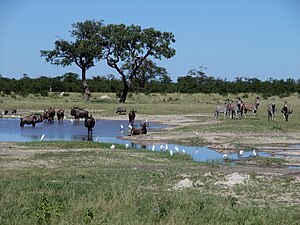Chobe National Park
|
Chobe National Park
|
|
|
Blue wildebeest and plains zebra in Chobe National Park |
|
| location | Botswana |
| surface | 10,566 km² |
| WDPA ID | 600 |
| Geographical location | 18 ° 40 ′ S , 24 ° 30 ′ E |
| Setup date | 1967 |
| administration | Department of Wildlife and National Parks |
The Chobe National Park ( Chobe National Park ) is a national park in Botswana . It was established in 1967 as the country's first national park shortly after its independence. A larger settlement existed in the park area, which was gradually reduced in size. No people have lived in the park since 1975. Due to extensions in 1980 and 1987, the Chobe National Park reached its current size of 10,566 km². Its ecosystem also includes the 2400 km² Chobe Forest Reserve in the north, the 1200 km² Kasane Reserve in the northeast and the Maikaelelo Reserve in the south with 300 km². The national park is 900 meters above sea level on the four-country corner of Namibia's Caprivi Strip , Zambia, Zimbabwe and Botswana and has an annual rainfall of 500 to 600 mm. It is part of the planned cross-border protected area Kavango-Zambezi .
The national park was named after the Chobe River, which forms the northern boundary of the park for over 35 kilometers. The Chobe comes from Angola and is called Cuando there. The Chobe district , in which the park is located, is named after the river . The Chobe National Park is known for the huge herds of elephants and cape buffalo and forms the south of the range of the puku . Particularly high game concentrations can be found around the Savuti River in the Mababesenke, which was once a large lake.
vegetation
The region's vegetation consists mainly of tree and bush savannahs. Typical bank vegetation stretches along the Chobe River east of Ngoma. In addition to the lush gallery forest and grass savannahs, there is also the rather dry Mopane area.
Wildlife
Chobe is particularly known for its large herds of elephants. In the 2004 dry season, around 30,000 animals gathered in the national park. In 2009, official censuses showed around 120,000 animals. In the area of the Savuti River, young and teenage elephants are regularly prey to lions, especially during periods of drought.
The Chobe area is home to numerous other large mammal species. In addition to lions, large predators are represented by spotted hyenas , cheetahs , leopards and wild dogs . Plains zebras can be found here, as well as giraffes , hippos and warthogs . The bush pig has also been found on the Chobe River . Cape buffalo are common. Numerous species of antelope are part of the fauna of the area. The larger among which are Topi , hartebeest , wildebeest , eland , greater kudu , sable antelope , roan antelope , impala , waterbuck , lechwe , Puku , reedbuck and bushbuck . The sitatunga occurs in the area of the Linyanti swamps . Smaller species are crown duiker , ibex , Sharpe ram, and the rare oribi , which is restricted to the north in Botswana. Springbok and spitbuck occur in the dry zones adjacent to the south. The park also has a rich bird life.
Pride of lions with dead Cape buffalo in the national park
Great kudu on the Chobe River
White-backed vultures on the Cuando
Bear baboons ( Papio ursinus )
See also
literature
- Wally and Horst Hagen: The African national parks as habitats for elephants . In: Vitus B. Dröscher (Ed.): Save the elephants of Africa . 1st edition. Goldmann Verlag , Munich 1990, ISBN 3-442-12322-4 , p. 255 f .
Web links
- Information about the Chobe National Park at chobe.com (English)
- www.botswanatourism.co.bw - Website of the national park at the Botswana Ministry of Tourism (English)
swell
- ^ A b G. Child (1968): An Ecological Survey of Northeastern Botswana. (PDF; 10.6 MB) FAO, # TA2563. Rome.
- ^ R. John Power, RX Shem Compion: Lion Predation on Elephants in the Savuti, Chobe National Park, Botswana . African Zoology 44 (1): 36-44. 2009 doi : 10.3377 / 004.044.0104 online (article requiring login).










